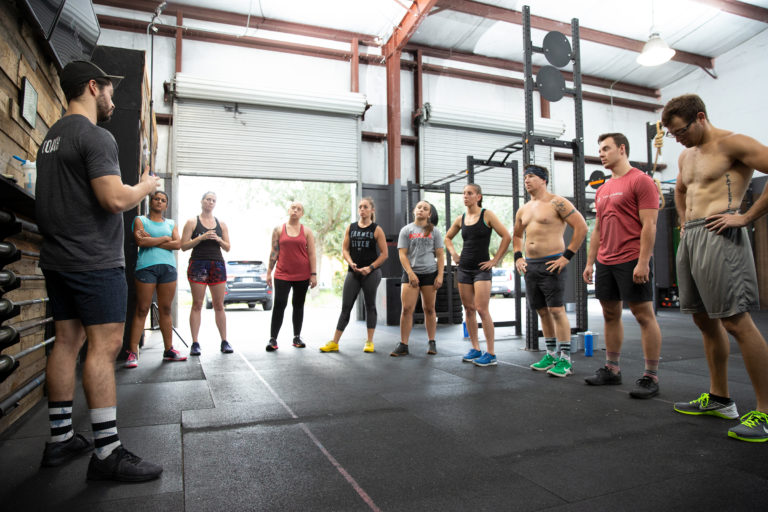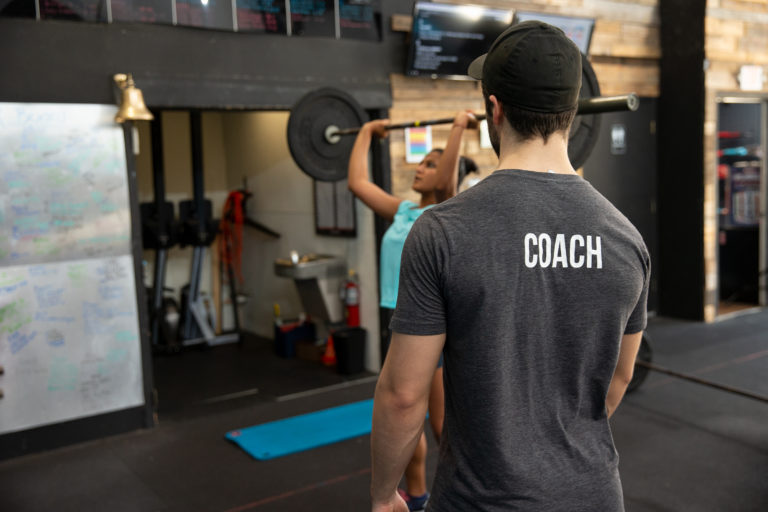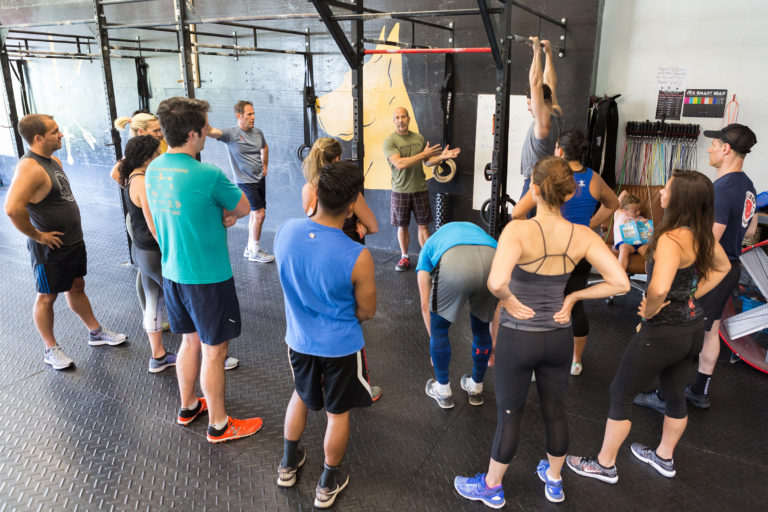Establishing a Consistent Class Structure for Affiliate Group Classes
The 2006 CrossFit Journal article “Scaling Professional Training” discusses the benefits and challenges of running group classes: “All the demands on the trainer skyrocket in this situation … attention, enthusiasm, voice projection, and engagement all have to escalate. It is an acquired skill — an art, really.”
Fast-forward 15 years and the group class model has become industry standard within the walls of CrossFit affiliates everywhere. How those classes are coached, executed, and managed is paramount to the success of the business, as in many regards, the group class is the product being delivered. How that product is delivered drives the professionalism of your operations, coach development, athlete development, community, and more.
Having a consistent and well-thought-out cadence for those classes can contribute to the overall success of your athletes, coaches, and gym. There are various approaches to creating a consistent class structure, and each comes with a few relative advantages and disadvantages. Factors such as the age of the affiliate, staffing and experience levels, the expertise of the coaches, and programming at any given point during the life cycle of an affiliate should all be taken into consideration when selecting the approach that will be most effective at ensuring your affiliate can thrive.
WHAT IS A CONSISTENT CLASS STRUCTURE?
While every gym does not need to run exactly the same, exemplary affiliates are operating with systems and protocols in place to provide quality service. Many gyms find success in their group classes by following a formulaic structure.
Most commonly, we see the affiliate class follow this structure:
- Whiteboard
- General Warm-Up
- Specific Warm-Up
- Workout
- Cool-Down, Score Collection, and Skill Work
Planning for each of the above sections is often reflected in a class plan. A class plan is simply a detailed plan of attack that adequately prepares for all elements of a class, from timeline and flow, to equipment spacing and safety, to teaching and skill development, to movement progressions and scaling — to name a few.
While the contents of each piece of an effective class plan warrant discussion, we want to focus on how the consistent class structure drives various areas of the affiliate business.

HOW A CONSISTENT CLASS STRUCTURE WILL SUPPORT ALL AREAS OF YOUR BUSINESS
Implementing a class structure teaches your athletes how to train and defines what you do. Frequently, we hear from athletes who are new to CrossFit that they have “never lifted weights before” or “never played sports in high school.” That’s fine, but it does mean we need to establish an order and trusted process for how they will experience each class.
The seasoned athletes at your gym who are serious about their training and the hour they commit to their fitness each day deserve a training landscape that matches their effort. Consistency in the training experience we provide defines what we do, sets the bar for our athletes, and drives better results into every corner of the business.
Trainer Development
Pairing a consistent class structure with effective class plans drives coach development. Successful affiliates know the quality of their trainers plays a pivotal role in the development and success of their athlete base. When coaches must go through the process to write their own class plan or follow another coach’s plan, it ensures they are actively developing the skills needed to progress as a coach. Designing a plan that covers the needs of each class session is an important skill for all trainers to master.
Additionally, when coaches prepare a clear plan for a group class, they can then focus their attention on higher-level coaching during each session. Having a plan that covers class organization, timeline management, and teaching progressions has a direct impact on the ability of the coach to teach, see, and correct movement.
Athlete Development
A predictable class structure means a class will run more efficiently, because athletes will know what to expect when they show up. This, in turn, frees up precious minutes to allocate to skill work and practice. Over time, the additional seven to 10 minutes saved through preparation yields a higher rate of athlete development. Coaches can fill that time with consistent focused practice and development of basic skills. From walking on your hands to muscle-ups, some skills benefit from frequent and structured dosing, and we owe it to our athletes to back up the messaging with dedicated class time.
Moreover, athletes who know their coach executes on a plan are less likely to skip workouts that contain elements in which they lack capacity. For example, an athlete who cannot yet do handstand push-ups might want to skip class upon seeing them programmed. But if that athlete knows their coach will provide an appropriately challenging scaled option and will coach them through the workout, they are less likely to skip. Athlete development accelerates when coaches have a plan that promotes consistency and includes dedicated time to shore up weaknesses.
Operations
Having a plan allows for continual improvement in the efficiency of day-to-day operations. When a class plan is consistently impeded by poor organization on the gym floor or leads to bottlenecks that eat up time, the coach is quickly made aware of the problem and works to come up with a solution. This, in turn, makes for more efficient transitions, less milling around, and less confusion.
The application of a class plan can also drive the scalability of your business. When one trainer is writing the class plans for the staff to follow, it not only decreases the amount of work from the team but also drives team cohesion and a consistent message.
Professionalism
As with every career path, there are professional and unprofessional approaches to coaching. A professional trainer’s work is illuminated by the care, effort, empathy, and consistency they bring to the training floor every day. It begins with starting and ending class on time, as this reflects the trainer’s respect for the time and lives of their athletes outside their commitment in the gym. An obvious way to develop and deliver on the promise of professional training is through delivering an excellent class.

Community
A well-run class drives cohesion and trust while delivering value to athletes. When the coach is ill prepared or unable to care for all athletes in the class, the glue that binds a community together becomes compromised.
As the CrossFit Journal explained in 2006, “The social dynamic of group classes is extremely powerful. Run correctly, they motivate an athletic output that is only rarely matched in one-on-one training.”
With everyone on the same page, the group learns to work together and shares in how they experience class, further enhancing the community.
HOW IS IT DONE?
Affiliates successfully apply class planning in a number of ways.
One Coach Writes All the Plans
In this model, one coach takes on the responsibility of writing the class plan for every class. This responsibility can be shared, meaning a different coach can be assigned the task for a week or a month at a time; however, one coach is responsible for producing a plan for every day for a set period of time.
A Different Coach Writes a Class Plan for Each Day of the Week
In this model, a different member of the coaching staff writes the class plan for one day of every week. For example, one coach is assigned to write the class plans for Mondays, a different coach for Tuesdays, and so on. Often, the coach who writes the class plan for the day is the early morning coach so any changes or tweaks that need to be made can be communicated to the other coaches on the team.
The Head Coach Gives Class Plan Guidelines
In this model, the head coach will provide general guidelines for how they want each day’s classes to unfold. These guidelines can include specifics such as intended stimulus, time domain, scaling options, and warm-up movements. Within those guidelines, it is up to each coach to write their own class plan for the classes they teach that day.
The Affiliate Utilizes a Third-Party Programming and Class Planning Service
In this model, the affiliate outsources its programming to a third party. Each workout is delivered with a class plan that often includes a timeline, general warm-up, movement progressions, scaling options, and more.
Additional Considerations
As with any system or structure, there are benefits and drawbacks to each of the class planning protocols described above.
One Coach Writes All the Plans
When one coach is assigned to write all the class plans for a set period of time, they can build continuity around what they have written earlier that week. For example, a coach might work a kipping pull-up progression into the warm-ups over the course of an entire week. Additionally, since this duty can be assigned to one coach, the rest of the staff can be freed up to focus on other tasks.
The drawback is that this is a large heap of work for one individual to tackle on an ongoing basis. This method makes significant demands on a coach’s time and creativity. It also can prevent newer coaches from having exposure to and practice with writing their own class plans.
One Coach Writes a Class Plan for Each Day of the Week
The benefit to this model is that it gives every coach at the affiliate, from beginner to advanced coaches, a touchpoint for development. Each coach gets a chance to write at least one class plan per week. There is often space for individuality and unique contribution from each coach, and coaches can learn from seeing and executing one another’s work.
The drawback to this plan is that coaches will need to review what has been done the previous few days to avoid repetition of various warm-ups, progressions, or other class components.

The Head Coach Gives Class Plan Guidelines
The benefit to this model is that it allows a supreme level of individuality for your coaches. One coach’s 6 a.m. class might be very different from another coach’s 5 p.m. class, but the nuts and bolts are the same.
The drawback to this model is that it requires more total hours of planning, work, and prep from the coaching staff.
The Affiliate Utilizes a Third-Party Programming and Class Planning Service
The benefit to this model is that it dramatically cuts down on the work and total hours spent by the affiliate on class planning.
The drawback is that coaches do not go through the skill development associated with learning to create and execute their own class plans.
GETTING READY TO IMPLEMENT STRUCTURE
To start, we recommend coaches review the class plan for 15 to 30 minutes prior to teaching the class. For most coaches, in the beginning, it will take 30 minutes to do this effectively. With practice and repetition, coaches will be able to prepare for class in 10 to 15 minutes.

Additionally, many coaches will write the major points of a class plan (such as the warm-up, progressions, or workout start time) on a sticky note or 3-by-5 card to reference during the class. When transitioning to class plans, many coaches find the stress of mental planning decreases and they’re able to go into every class with more confidence.
Remind your coaches that having a plan and structure does not mean the end of creativity. Similar to a coloring book, the class plan provides the lines, and how you color within those lines is completely up to you. Once coaches begin to adhere to a class plan, they often find that it provides more room for individuality, as the mental energy to calculate timelines, intended stimulus, and more are removed from their process.
Many factors contribute to how an affiliate might decide to implement a consistent class structure. And many affiliates will experiment with different methods of implementation at different times in the life cycle of their business. The needs of the gym, the coaching staff’s interest level in class plan writing, and the experience and coaching goals of the staff should all be taken into consideration throughout the process.
About the Author
Nicole Christensen is the owner of CrossFit Roots in Boulder, Colorado, a Certified CrossFit Coach (CF-L4), CrossFit Seminar Staff Flowmaster, and Senior Content Developer at CrossFit. She is the Managing Editor of the Professional Coach publication and enjoys coaching athletes in group classes at her affiliate.
Comments on Humans Crave Structure
I find that teaching the structure to my athletes is as important as having a structure. It saves a lot of time or group management and allows for more coaching time. It also reduces the stress of the workout witch we tend to forget but a lot of athletes still have that little stress every time they come to class. They cannot control the WOD but they can expect the structure.
As a coach I struggle with plan implementation when I am unable to perform the movement myself. Pull up, toes-to bar, HSPU, ect. I get thru progressions ok. My understanding is in the ability to explain (articulate) what you want the person to do... or have an athlete demo. Suggestions appreciated.
I would suggest to tell our athletes what strategies are we implementing to fill the technical gap, keeping it honest. It can motivate and inspire them to be better. There's also a huge movement library, now, to use as reference, and in some cases we can also have a well experienced athlete provide the demo. Whatever we do, we just need to plan in advance an allocate the right time. Hope it can be of help.
Yes! We appreciate the direction that we are moving and are proud to be part of this organization. Really looking forward to the programming that we can test out from CAP.
Great article for owners & coaches. It is so great to see where CrossFit is going with the education of coaches.
Plans save time, stress, headaches and heartaches. I do my best to review plans then follow and flow with them. That said, I can always do better. I mostly look at plans as a framework as flexibility can ne required at times due to in-the-moment matters arising.
This article is very helpful. It gave me a few ideas how we can do it better
Thank you
Humans Crave Structure
7